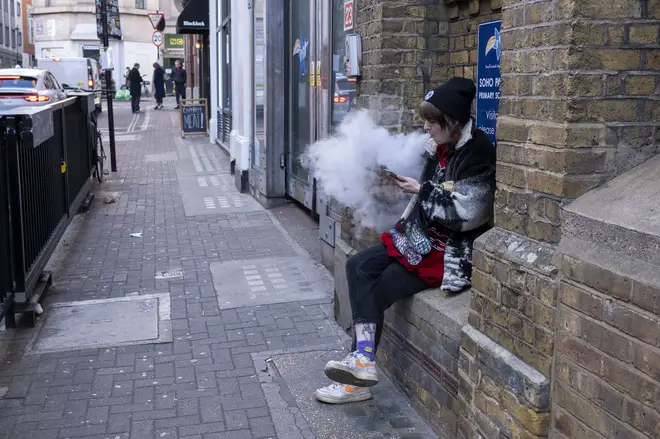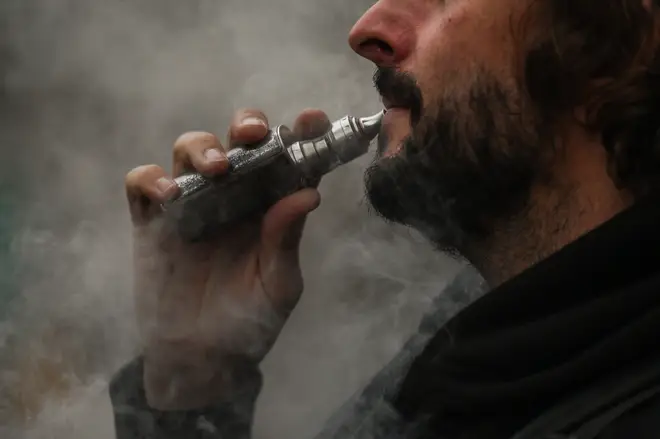
Clive Bull 1am - 4am
2 February 2023, 06:00 | Updated: 3 February 2023, 06:55

The number of hospital admissions linked to vaping among children has quadrupled in the past year, LBC can reveal.
Figures obtained by LBC from NHS Digital show 32 admissions of patients under the age of 18 were recorded as being linked to a vaping-related disorder in England last year. There were just eight in 2021.
Overall admissions across all age groups almost doubled in 2022, with 344 recorded. Concerns have been growing around the increasing number of young people being attracted to e-cigarettes through “flashy marketing campaigns”, fruity flavours and colourful packaging.
Read more: 'I almost died': Teenager warns against vaping
Read more: No danger to the public from passive vaping, expert claims
Waitrose became the latest supermarket to stop selling disposable vapes over concerns about children using them, while police have been cracking down on shops who illegally sell them to under-18s.
Charlie, from North London, said she was taken aback when her younger sister, just 13 at the time, revealed she had become addicted to vapes.

She told LBC: “She, at that point in nine months, had racked up over £2,000 on vapes and had a massive collection of them - like every brand, every flavour.
“It was a massive binful - and she was definitely glorifying it. She saw them as being kind of like collectables, like when we were younger, we used to collect cards, except I guess now teenagers collect vapes.
“It got to a point, though, where she had like a 60-year-old smoker’s cough, like that really deep Covid cough. She’s always had really beautiful skin but she started looking a bit grey.
“She ended up texting me at like 1am during the week saying ‘I need to go to hospital’ - but she was worried about mum finding out about her vaping.”

The latest survey by the anti-smoking charity ASH suggests around 17% of 11-17 year-olds have tried vaping at least once, while 7% identified themselves as being a regular user.
The charity said that tobacco cigarettes have contributed to a much higher rate of hospital admissions, but shared concerns at the figures.
Deborah Arnott, chief executive of ASH, told LBC: "We certainly take concerns about health problems being linked to vaping seriously. However, although the number may have increased in the last couple of years it is still small by comparison with smoking which causes more than five hundred thousand hospital admissions every year.
"Smoking is proven to cause cancer, heart and respiratory disease in adults, and exposure to tobacco smoke causes cot death, respiratory disease and meningitis in children.
"Although we should take steps to limit e-cigarette marketing that appeals to children and to prevent illegal sales, by far the main impact of vaping on public health is to help smokers to quit and to reduce children's exposure to passive smoking."
One parent, Kelly, from the Scottish Borders, told LBC about her 12 year-old daughter being offered vapes for £5 by a friend at school, who had been using his mum’s Amazon account to buy them online.
She said: “I found the text on her phone, where he was saying ‘if I sell two more, I get free delivery’.
“And this was at like 11pm on a Sunday, so he was clearly buying them to sell in the playground through the week - taking orders and dishing them out.
“Some are stealing them from their parents too if they see them lying about the house - I’ve heard of so many of them going missing.”

Police raid vape shops selling cannabis
The long-term effects of smoking e-cigarettes is still not fully known, with researchers continuing to look closely at the data.
But the figures obtained by LBC through a freedom of information request showed hospital admissions for vaping-related disorders - such as lung or organ damage - increased across all age groups last year.
Under-18s showed the biggest rise, including 15 vaping-related admissions in children aged 0-10.
Andrew Bush, professor of paediatric respirology at Imperial College London said: “These things haven’t been around long enough for us to have the long-term data. People my age don’t have to think about what’s going to happen in 30 years' time but somebody who’s a teenager needs to think about 30, 40 ,50 ,60 years’ time.

“It seems to be a rare complication but the more people who take things up the more complications you’ll see so yes, I’m worried about these figures going up, especially among young people.
“I hope it’ll slow down but I doubt it will without action from the regulators - we are completely out of step with the rest of the world on that front, where e-cigarettes are concerned”.
There have been calls for tougher regulations, including among manufacturers.
Members of the UK Vaping Industry Association have demanded the introduction of a licensing scheme and support from trading standards to combat youth vaping numbers and reduce retailers who are breaking the law around selling vapes to children.
A Department of Health and Social Care spokesperson said: "The government remains committed to its bold ambition to be Smokefree by 2030, and the action we are taking means smoking rates in England are at an all-time low: currently at 13% and down from 20% in 2010.
"We have some of the strongest regulations in place to prevent children and young people from vaping. The law protects children from e-cigarettes through restricting sales to over 18s only, limiting nicotine content, refill bottle and tank sizes, labelling requirements and through advertising restrictions."